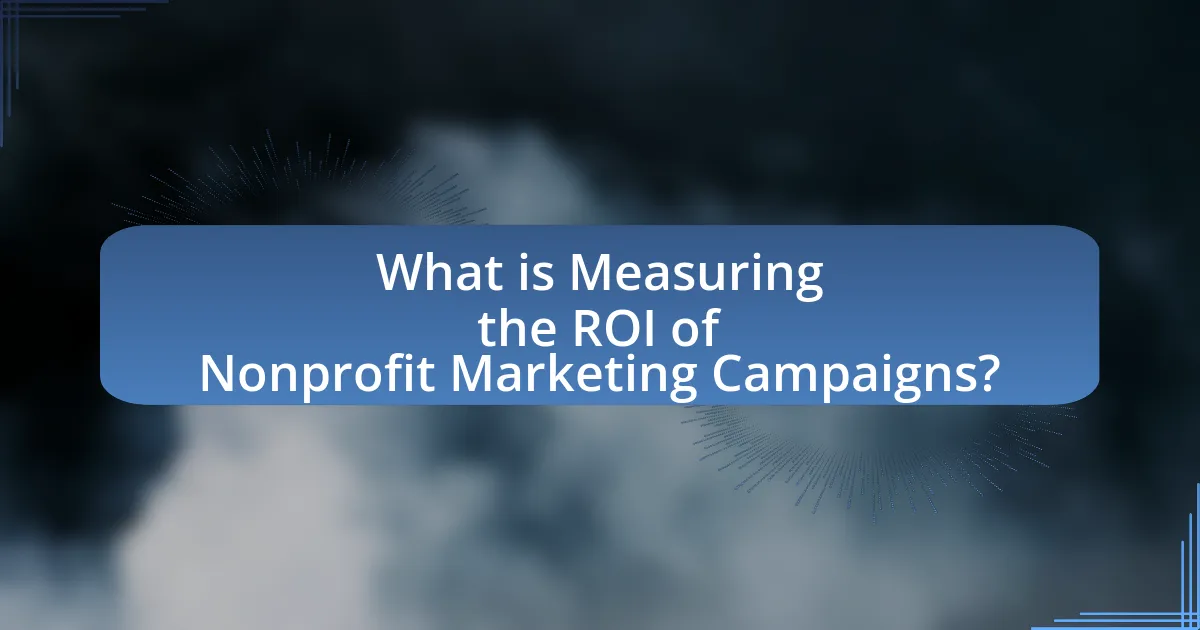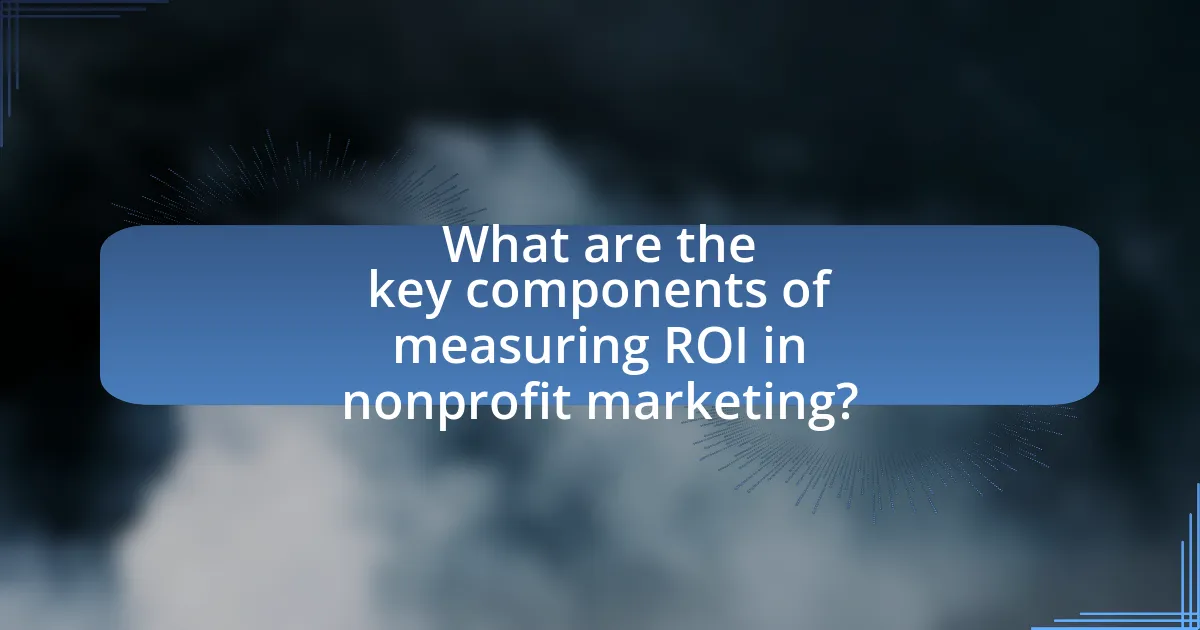Measuring the ROI of nonprofit marketing campaigns is a critical process that evaluates the financial return generated from marketing investments relative to their costs. This article outlines the definition of ROI in nonprofit marketing, the metrics used for calculation, and the importance of measuring ROI for effective resource allocation and enhanced organizational impact. It also discusses the challenges nonprofits face in measuring ROI, including difficulties in data collection and attributing revenue to specific campaigns, while providing strategies to overcome these obstacles. Additionally, the article highlights the role of digital marketing in improving ROI and offers best practices for nonprofits to ensure accurate assessment and continuous improvement in their measurement processes.

What is Measuring the ROI of Nonprofit Marketing Campaigns?
Measuring the ROI of nonprofit marketing campaigns involves evaluating the financial return generated from marketing investments relative to the costs incurred. This process typically includes quantifying the revenue generated from donations, grants, or other funding sources directly linked to marketing efforts and comparing it to the total expenses of those campaigns. For instance, a study by the Nonprofit Marketing Guide found that organizations that effectively measure their marketing ROI can increase their fundraising efficiency by up to 30%. This demonstrates that understanding ROI not only helps nonprofits allocate resources more effectively but also enhances their overall impact and sustainability.
How is ROI defined in the context of nonprofit marketing?
ROI in the context of nonprofit marketing is defined as the ratio of net income generated from marketing efforts to the costs incurred in those efforts. This metric helps nonprofits evaluate the effectiveness of their marketing campaigns by quantifying the financial return relative to the investment made. For instance, if a nonprofit spends $10,000 on a campaign and generates $50,000 in donations, the ROI would be calculated as ($50,000 – $10,000) / $10,000, resulting in an ROI of 4, or 400%. This calculation demonstrates the financial impact of marketing strategies and aids in decision-making for future campaigns.
What metrics are used to calculate ROI for nonprofit campaigns?
The metrics used to calculate ROI for nonprofit campaigns include total donations received, campaign costs, donor acquisition costs, and donor retention rates. Total donations received quantify the financial contributions generated by the campaign, while campaign costs encompass all expenses incurred during the campaign execution. Donor acquisition costs measure the expenses associated with attracting new donors, and donor retention rates indicate the percentage of existing donors who continue to contribute over time. These metrics collectively provide a comprehensive view of the campaign’s financial effectiveness, allowing nonprofits to assess their return on investment accurately.
How do financial and non-financial returns factor into ROI?
Financial and non-financial returns significantly influence the calculation of ROI by providing a comprehensive view of the value generated by an investment. Financial returns, such as increased donations or revenue, are quantifiable and directly impact the ROI formula, which is calculated as (Net Profit / Cost of Investment) x 100. Non-financial returns, including brand awareness, community engagement, and volunteer recruitment, contribute to the overall effectiveness of nonprofit marketing campaigns but are often harder to quantify. For instance, a study by the Nonprofit Marketing Guide found that organizations reporting increased community engagement saw a 30% rise in volunteer participation, illustrating how non-financial metrics can enhance the perceived value of financial returns. Thus, both types of returns are essential for a holistic assessment of ROI in nonprofit marketing efforts.
Why is measuring ROI important for nonprofit organizations?
Measuring ROI is important for nonprofit organizations because it enables them to assess the effectiveness and impact of their marketing campaigns. By quantifying the return on investment, nonprofits can make informed decisions about resource allocation, ensuring that funds are directed toward the most successful initiatives. For instance, a study by the Nonprofit Finance Fund found that organizations that measure their ROI are 50% more likely to achieve their mission-related goals. This data underscores the necessity of ROI measurement in optimizing strategies and enhancing overall organizational performance.
What impact does ROI measurement have on funding and support?
ROI measurement significantly influences funding and support by providing quantifiable evidence of a nonprofit’s effectiveness and impact. When organizations can demonstrate a positive return on investment, they are more likely to attract funding from donors and grant-making bodies, as these stakeholders seek assurance that their contributions will lead to tangible results. For instance, a study by the Nonprofit Finance Fund found that nonprofits that effectively communicated their ROI were able to secure 30% more funding than those that did not. This correlation underscores the importance of ROI measurement in enhancing credibility and fostering trust among potential supporters.
How can ROI insights improve future marketing strategies?
ROI insights can significantly enhance future marketing strategies by providing data-driven evidence of what works and what doesn’t. By analyzing past campaign performance, organizations can identify the most effective channels and tactics, allowing for better allocation of resources. For instance, a study by the Nonprofit Marketing Guide found that nonprofits that measure ROI are 50% more likely to report increased funding. This data enables marketers to refine their approaches, focusing on high-impact strategies that yield the best returns, ultimately leading to more successful campaigns and improved donor engagement.

What are the key components of measuring ROI in nonprofit marketing?
The key components of measuring ROI in nonprofit marketing include defining clear objectives, tracking costs, measuring outcomes, and analyzing data. Clear objectives establish what the nonprofit aims to achieve, such as increased donations or volunteer engagement. Tracking costs involves documenting all expenses related to marketing efforts, including staff time, materials, and advertising. Measuring outcomes requires assessing the impact of marketing campaigns, typically through metrics like funds raised or new donors acquired. Finally, analyzing data allows organizations to compare the financial return against the costs incurred, providing a clear picture of the ROI. For instance, a study by the Nonprofit Marketing Guide found that nonprofits that effectively measure ROI can increase their fundraising efficiency by up to 30%.
What types of data are essential for calculating ROI?
To calculate ROI for nonprofit marketing campaigns, essential data types include total revenue generated, total costs incurred, and the time frame of the campaign. Total revenue generated reflects the financial contributions or funds raised as a direct result of the campaign, while total costs incurred encompass all expenses related to the campaign, such as marketing materials, advertising, and staff time. The time frame is crucial as it helps contextualize the revenue and costs, allowing for a clear calculation of ROI over a specific period. Accurate ROI calculations require these data types to assess the effectiveness and financial impact of marketing efforts in the nonprofit sector.
How can nonprofits collect relevant data effectively?
Nonprofits can collect relevant data effectively by implementing structured data collection methods such as surveys, interviews, and analytics tools. These methods allow organizations to gather quantitative and qualitative insights directly from their target audience, ensuring the data reflects the needs and preferences of stakeholders. For instance, utilizing online survey platforms can yield high response rates, with studies showing that well-designed surveys can achieve completion rates of over 30%. Additionally, nonprofits can leverage social media analytics to track engagement metrics, providing real-time data on audience interactions. By combining these approaches, nonprofits can create a comprehensive data set that informs their marketing strategies and measures the ROI of their campaigns accurately.
What tools and software can assist in data collection and analysis?
Tools and software that assist in data collection and analysis include Google Analytics, SurveyMonkey, and Tableau. Google Analytics provides insights into website traffic and user behavior, enabling nonprofits to measure the effectiveness of their marketing campaigns. SurveyMonkey allows organizations to gather feedback and data from stakeholders through customizable surveys, which can inform decision-making. Tableau offers powerful data visualization capabilities, helping nonprofits analyze complex datasets and present findings in an accessible format. These tools are widely used in the nonprofit sector to enhance data-driven strategies and improve campaign ROI.
How do different marketing channels affect ROI measurement?
Different marketing channels significantly impact ROI measurement by influencing how costs and revenues are attributed to specific campaigns. For instance, digital channels like social media and email marketing often provide more precise tracking of user engagement and conversion rates, allowing for clearer ROI calculations compared to traditional channels such as print advertising, which may rely on estimates and broader audience reach metrics. A study by HubSpot found that businesses using multiple digital marketing channels experienced a 24% higher ROI than those relying on a single channel, highlighting the importance of channel diversity in effective ROI measurement.
What are the ROI implications of digital marketing versus traditional marketing?
Digital marketing typically offers a higher ROI compared to traditional marketing due to its cost-effectiveness and measurable results. For instance, a study by HubSpot found that inbound marketing, which includes digital strategies, can generate 54% more leads than traditional methods while costing 62% less. Additionally, digital marketing allows for real-time analytics, enabling organizations to adjust campaigns quickly based on performance data, further enhancing ROI. In contrast, traditional marketing often involves higher upfront costs and lacks the same level of tracking and optimization capabilities, leading to less efficient allocation of resources.
How can nonprofits evaluate the effectiveness of various marketing channels?
Nonprofits can evaluate the effectiveness of various marketing channels by analyzing key performance indicators (KPIs) such as conversion rates, engagement metrics, and return on investment (ROI). By tracking these metrics, nonprofits can determine which channels drive the most donations, volunteer sign-ups, or event registrations. For instance, a study by the Nonprofit Marketing Guide found that organizations that measure their marketing efforts are 50% more likely to report increased donations. Additionally, utilizing tools like Google Analytics allows nonprofits to assess website traffic sources, while social media insights provide data on audience engagement. This data-driven approach enables nonprofits to allocate resources effectively and optimize their marketing strategies.

What challenges do nonprofits face in measuring ROI?
Nonprofits face significant challenges in measuring ROI due to the difficulty in quantifying social impact and the lack of standardized metrics. The intangible benefits of nonprofit activities, such as community well-being and social change, are hard to translate into financial terms, making it challenging to assess the true value of their efforts. Additionally, many nonprofits lack the resources and expertise to implement sophisticated measurement tools, which can lead to inconsistent data collection and analysis. According to a 2021 report by the Nonprofit Finance Fund, 60% of nonprofits reported that measuring impact is a major challenge, highlighting the widespread nature of this issue.
What common obstacles hinder accurate ROI measurement?
Common obstacles that hinder accurate ROI measurement include difficulty in attributing revenue to specific marketing efforts, lack of standardized metrics, and challenges in data collection. Nonprofits often struggle to link donations directly to marketing campaigns due to multiple influencing factors, making it hard to isolate the impact of each initiative. Additionally, the absence of universally accepted metrics for measuring success can lead to inconsistent evaluations across different campaigns. Furthermore, data collection issues, such as incomplete donor information or inadequate tracking systems, can result in gaps that skew ROI calculations. These factors collectively complicate the ability to assess the true effectiveness of nonprofit marketing efforts.
How can nonprofits overcome data collection challenges?
Nonprofits can overcome data collection challenges by implementing streamlined data management systems and utilizing technology for efficient data gathering. By adopting tools such as customer relationship management (CRM) software, nonprofits can automate data entry and ensure accurate tracking of donor interactions and campaign performance. Research indicates that organizations using CRM systems report a 29% increase in data accuracy, which enhances their ability to measure the return on investment (ROI) of marketing campaigns effectively. Additionally, training staff on data collection best practices can further mitigate errors and improve the quality of collected data, leading to more informed decision-making.
What strategies can be employed to address resource limitations?
To address resource limitations in nonprofit marketing campaigns, organizations can implement strategies such as prioritizing high-impact activities, leveraging partnerships, and utilizing technology effectively. Prioritizing high-impact activities involves focusing on marketing efforts that yield the greatest return on investment, as evidenced by studies showing that targeted campaigns can increase engagement by up to 50%. Leveraging partnerships allows nonprofits to share resources and expertise, which can enhance outreach without incurring additional costs. Utilizing technology, such as social media and email marketing tools, can streamline communication and reduce expenses, with research indicating that digital marketing can be up to 62% cheaper than traditional methods. These strategies collectively enable nonprofits to maximize their limited resources while effectively measuring and improving their marketing ROI.
How can nonprofits ensure they are measuring ROI effectively?
Nonprofits can ensure they are measuring ROI effectively by establishing clear, quantifiable goals for their marketing campaigns. By defining specific objectives, such as increasing donor engagement or raising a targeted amount of funds, nonprofits can track relevant metrics like donation amounts, donor retention rates, and campaign reach. For instance, a study by the Nonprofit Marketing Guide found that organizations that set measurable goals were 50% more likely to report successful outcomes. This approach allows nonprofits to analyze the cost-effectiveness of their campaigns and make data-driven decisions for future initiatives.
What best practices should nonprofits follow for accurate ROI assessment?
Nonprofits should follow best practices such as clearly defining objectives, accurately tracking costs, and measuring outcomes to ensure accurate ROI assessment. Clearly defined objectives allow nonprofits to establish specific, measurable goals that align with their mission, facilitating a focused evaluation of marketing efforts. Accurate tracking of costs involves documenting all expenses related to campaigns, including direct costs like advertising and indirect costs such as staff time, ensuring a comprehensive understanding of investment. Measuring outcomes requires nonprofits to assess both quantitative metrics, such as funds raised or new donors acquired, and qualitative impacts, like community engagement or awareness raised, providing a holistic view of campaign effectiveness. These practices are supported by research indicating that organizations employing structured evaluation frameworks report higher accuracy in ROI calculations, leading to more informed decision-making and resource allocation.
How can nonprofits continuously improve their ROI measurement processes?
Nonprofits can continuously improve their ROI measurement processes by implementing data analytics tools that track and analyze campaign performance in real-time. By utilizing software solutions like Google Analytics or specialized nonprofit CRM systems, organizations can gather precise data on donor engagement, campaign reach, and conversion rates. Research indicates that nonprofits using data-driven strategies see a 20% increase in fundraising efficiency, as reported by the Nonprofit Research Collaborative. Regularly reviewing this data allows nonprofits to identify successful strategies and areas needing adjustment, fostering a culture of ongoing improvement in their ROI measurement practices.
What practical tips can nonprofits implement to enhance ROI measurement?
Nonprofits can enhance ROI measurement by implementing clear metrics and data tracking systems. Establishing specific, measurable goals for each campaign allows organizations to evaluate performance effectively. Utilizing tools like Google Analytics or CRM software enables nonprofits to collect data on donor engagement, conversion rates, and campaign reach. Regularly analyzing this data helps identify successful strategies and areas for improvement. Additionally, conducting surveys to gather feedback from stakeholders can provide qualitative insights that complement quantitative data, leading to a more comprehensive understanding of ROI.


